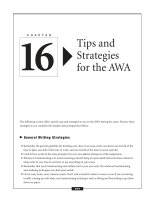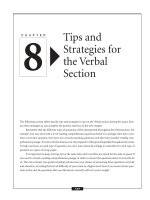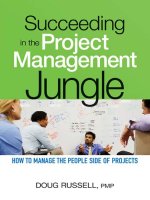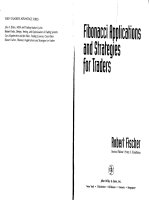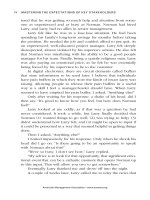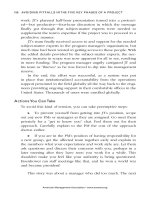HR from the heart inspiring stories and strategies for building the people side of great business
Bạn đang xem bản rút gọn của tài liệu. Xem và tải ngay bản đầy đủ của tài liệu tại đây (1.62 MB, 272 trang )
HR from the Heart
Inspiring Stories and Strategies for Building
the People Side of Great Business
Libby Sartain
with
Martha I. Finney
American Management Association
New York • Atlanta • Brussels • Buenos Aires • Chicago • London • Mexico City
San Francisco • Shanghai • Tokyo • Toronto • Washington, D. C.
Special discounts on bulk quantities of AMACOM books are available to corporations, professional associations, and other organizations. For details, contact Special
Sales Department, AMACOM, a division of American Management Association,
1601 Broadway, New York, NY 10019.
Tel.: 212-903-8316 Fax: 212-903-8083
Web site: www.amacombooks.org
This publication is designed to provide accurate and authoritative information in regard
to the subject matter covered. It is sold with the understanding that the publisher is not
engaged in rendering legal, accounting, or other professional service. If legal advice or
other expert assistance is required, the services of a competent professional person
should be sought.
Library of Congress Cataloging-in-Publication Data
Sartain, Libby, 1954HR from the heart : inspiring stories and strategies for building the
people side of great business / Libby Sartain with Martha I. Finney.
p. cm.
Includes bibliographical references and index.
ISBN 0-8144-0756-0
1. Personnel management. 2. Personnel departments—Management.
3. Personnel management—Vocational guidance. 4. Customer relations.
5. Industrial relations. I. Finney, Martha I. II. Title.
HF5549 .S1753 2003
658.3—dc21
2002152889
© 2003 Libby Sartain and Martha I. Finney.
All rights reserved.
Printed in the United States of America.
This publication may not be reproduced,
stored in a retrieval system,
or transmitted in whole or in part,
in any form or by any means, electronic,
mechanical, photocopying, recording, or otherwise,
without the prior written permission of AMACOM,
a division of American Management Association,
1601 Broadway, New York, NY 10019.
Printing number
10 9 8 7 6 5 4 3 2 1
Dedication
From Libby
This book is dedicated to my parents, Parks and Sarah Pedrick, who, despite
all the zany, hair-brained, and wild ideas I pursued, made sure that I was
instilled with a strong foundation of core values and personal beliefs.
From Martha
For Alan Downs, Melanie “Miel” Keveles, and Judi Neal—for everything
that matters more than anything.
This Page Intentionally Left Blank
Contents
Foreword by Susan R. Meisinger, SPHR, President and CEO,
Society for Human Resource Management
viii
Acknowledgments
xi
Introduction
xv
PART 1:
Your Own Career Is Your Best HR Asset
HR Is a Calling
1
Chapter 1: What’s Love Got to Do with It?
3
3
Chapter 2: The Sacred Trust That Is HR
6
Lessons Learned from the School of Hard Knocks
Chapter 3: Six Essential Ingredients of Every Great HR Career
11
11
Chapter 4: Sure It Looks Great, But Does It Fit?
17
Chapter 5: Not Everyone Will Be President of Your Fan Club
22
Chapter 6: Great Relationships Are More About What You Give
Than What You Get
27
Chapter 7: Pull Up a Chair . . . (How to Know You’re Really
Ready for a Seat at the Table)
32
Chapter 8: . . . And Have a Seat (What to Do Once You
Finally Get There!)
39
Chapter 9: From the Heart Doesn’t Mean From the Bleeding Heart
42
No Fear: Credibility and Confidence
47
Chapter 10: Know Your Stuff and Know That You Know Your Stuff
(And Don’t Let Anyone Tell You Otherwise)
47
v
vi
Contents
Chapter 11: Just Because They’re the Experts Doesn’t Make
Them More Right Than You
53
Chapter 12: Question Authority
57
Chapter 13: Start Your Own Hole-in-the-Wall Gang
62
Chapter 14: The Dais of Our Lives
65
Take Charge of Your HR Career
Chapter 15: Can This Marriage Be Saved?
71
71
Chapter 16: How to Know When It’s Time to Leave
77
Chapter 17: How to Get a Job That Is Far Better than the One
You Wanted
82
Chapter 18: Is That New Job You’re Considering in an HR-Friendly
Company?
87
Chapter 19: Welcome Aboard! (And Watch Your Step!)
94
PART 2:
HR Is Your Company’s Best Asset
101
Building a From-the-Heart HR Function—
And a World-Class Organization, While You’re at It
Chapter 20: It’s About People, Not Widgets!
103
103
Chapter 21: The Nuts and Bolts of the Talent Machine
109
Chapter 22: HR Does Not Create Culture
117
Chapter 23: Internal Branding: The Enchanting Power of the
People Promise
124
Chapter 24: The Power of People to Make Your HR Branding Work
131
Chapter 25: Who Is Really HR’s Customer?
136
Chapter 26: How to Make Your Company a Great Customer
Service Company
141
Chapter 27: Eight Ways to Sell the Value of Your Department
147
Chapter 28: The Truth Behind Those Best Employers Lists:
This Ain’t No Beauty Contest!
154
Chapter 29: Congratulations! You May Have Already Won!
159
Contents
A Day in the Life of HR
vii
Chapter 30: Show Them the Money!
164
164
Chapter 31: Using Benefits to Build Relationships
168
Chapter 32: Recognition, Rewards, Fun: The Triple Crown of
Employee Engagement
172
Chapter 33: Managing Expectations
181
Chapter 34: Soothing the Savage Skeptic
187
Chapter 35: The Most Important HR Policy: Throw Out the
Policy Manual (And Build Strong Managers Instead)
191
Chapter 36: Diversity Should Be From the Heart—Not Just by
the Book
197
Chapter 37: Use Your People Expertise to Create Successful
Mergers and Acquisitions
203
Chapter 38: “In the Unlikely Event of an Emergency”
209
Chapter 39: Judgment Day Made Simple and Painless
214
Chapter 40: Parting Company
219
Chapter 41: The Time to Plan for Layoffs Is Before You
Do the Hiring
224
Chapter 42: . . . And Then Someone Said, “No Good Deed
Goes Unpunished”
229
Chapter 43: You Are the Keeper of the HR Ethics
231
Chapter 44: Conclusion: How Do We Get There From Here?
237
Recommended Reading List
241
Index
247
About the Authors
253
Foreword
Have you ever wondered what the world would it be like if we could
read people’s minds? And if we could, how would that ability affect
the human resources (HR) profession? One thing is certain, we would
do away with much of the uncertainty we experience in workplace
relationships. And we could even quantify and evaluate the HR
processes and functions that previously eluded measurement, enhancing our efforts to perform at a high level, and helping others in the
organization improve their work as well.
Sounds like science fiction, right? Not really. There is a brave new
world of knowledge to which most of us pay little attention and few
have been able to measure. It is a body of knowledge that is as complex as the individuals who seek to obtain it.
Introspection. Self-awareness. Knowledge of ourselves.
Reading our own minds goes beyond acknowledging the basic
information required to be a competent employee, manager, or HR
professional. It is discovering the heart of who we are—our character, personality, ethics, and the ability to relate to others. Think
about how important such knowledge is in organizations of all
kinds, and its special relevance to those of us in HR as we seek to
attract and retain talented employees and develop and deliver policies and programs that improve workplace efficiency, creativity, and
productivity. The more we know about ourselves—the more we can
get into our own minds—the better able we are to assist the diverse
workforce we serve.
Ancient philosophers understood that. The Greek thinker and
teacher Socrates believed that the search for knowledge began with
introspection: “Know thyself.” He taught his students that they should
question themselves about various things in life. By following each
question with another question, the person would eventually realize
viii
Foreword
ix
that they had the final answer within themselves—or, in some cases,
that there was no final answer to be found. Psychologists say it is comparable to peeling an onion, discovering new complex behaviors as each
layer is revealed. The process is called the Socratic Dialogue or Method,
and it is still used among students of philosophy and law today.
But it is Greek to most of us. We either do not know it exists or, if
we do, we hardly ever use it due to the time constraints of competing
responsibilities. We as HR professionals focus on other people in the
organization without first establishing the basic foundation for understanding—knowledge of self.
Maybe that is why people are generally unaware of how they
interact with others in given situations. We do not spend enough time
evaluating how our personal values, feelings, strengths, and weaknesses affect our relationships and responsibilities in and outside of
the workplace. As managers, not understanding what makes us tick
can stifle our development because we are using less than 100% of our
internal resources. That can hurt our chances for achieving great success in the workplace.
Some researchers have classified this search for self-knowledge as
“Emotional Intelligence (EI).” Studies indicate (and quantify) just
how important it is: top performance is based on 80 percent EI compared with 20 percent for IQ. Adherents say that it can be taught. As
a result, measurement instruments are being developed and utilized.
Some organizations are even implementing EI strategies within their
workforces. But the entire concept is still dependent on an individual’s desire to pursue self-knowledge.
For HR professionals today, it is not enough that they focus on
acquiring self-knowledge for the sake of feeling good about themselves. Acquiring a keen sense of self is dependent on HR professionals becoming adept at reading the minds of their CEOs—knowing,
understanding and speaking the language of business. And for good
reason.
A number of strategic trends in the current business environment—the increasing value of human capital in the marketplace,
globalization of U.S. companies, and the emergence of technologies
that have changed (and continue to change) the fundamentals for
x
Foreword
how employees and their companies interact—have created a new set
of opportunities and challenges for the HR profession.
These opportunities and challenges demand that HR professionals
demonstrate mastery in both the technical and “human” HR competencies that set them apart as guardians of human capital management. It is the seamless integration of these skill sets—emotional
intelligence combined with business acumen—that makes a successful HR leader; one who can translate who they are and what they
know into tangible contributions that positively impact their organization’s bottom line.
It is this integration that is depicted in Libby Sartain’s book. And it
is this understanding of mind and heart, business know-how, and
from-the-heart passion, to which she challenges all of us to aspire.
Are we up for the challenge of discovering the mysteries contained in our own minds? If it means that we will acquire the skill set
required to evaluate the HR functions that have previously eluded
measurement, count me in. We have to start somewhere. For now,
starting the process is as simple as asking oneself a question.
Susan R. Meisinger, SPHR
President and Chief Executive Officer
Society for Human Resource Management
Acknowledgments
I am always amazed by the seemingly random way in which simple
decisions and circumstances can alter the course of our lives. Job
choices, new bosses, even a chance encounter with a stranger may
become the basis of future long-term relationships with talented and
wise people whose influence, support, mentoring, and friendship
shape our values and beliefs, form our communication styles, add to
our knowledge base, challenge our thinking, and make us who we
are. Without such blessings, my career experiences and the knowledge upon which this book is based would never have come about.
Even among old friends, a spark of inspiration, a casual remark, or a
suggestion can send us to surprising new destinations. At the
moment, I’m thinking specifically of a “good-bye” lunch that was held
for me as I was preparing to leave Southwest Airlines after thirteen
years. A long-time business friend, Harry Spring, persuaded me to
tackle this project. He said that if I didn’t write down exactly what I
thought had created the winning people formula at Southwest Airlines, no one would know what had worked so well during the years
I was there. My successors would add to and subtract from what we
did. It might be better or worse, but it would never be the same. He
said that it would be a gift to the HR profession if I shared what I had
learned. He also warned me that if I didn’t document what I had
learned, few would benefit from it. So I have Harry to thank first for
being the one to instigate this whole project.
I met my writing partner, Martha Finney, in another pivotal
moment—although I didn’t realize it at the time. I had just delivered
my “Hiring From the Heart” presentation to the Society for Human
Resource Management (SHRM) conference in Atlanta in 1999 when
she emerged from the audience and handed me her card. A business
journalist with an extensive background in writing about HR, she was
xi
xii
Acknowledgments
doing some empirical research into employee engagement and wanted
to introduce herself. But life goes on, and we were on separate tracks,
making separate decisions that would change our lives separately,
although we kept in touch from time to time. Then one coincidental
decision ultimately brought us back together: the decision to move to
northern California—I from Dallas, and she from Annapolis. So there
we were, both living in northern California, at the moment in time
when I decided to follow Harry’s advice and write a book. Martha
added the tremendous value of her understanding of HR, her experience in book publishing, and her wonderful writing style, which will
be obvious to the reader. I will be eternally grateful to Martha not only
for collaborating with me on the project, but also for sharing her
knowledge, teaching me the ropes, and making the arrangements with
AMACOM to publish the book, thus leading the way to our editor,
Adrienne Hickey. And thanks to Adrienne for being one of those skeptics who are good to have around because they keep you on your toes.
I am extremely thankful for so many people who have affected my
career in a significant way. A classmate at Southern Methodist University, Jim Symington, introduced me to a course on organizational
behavior that set me in pursuit of an HR career. Mick McGill, Fred
Crandall, Jim Tarter, Elvis Stephens, and Frank Rachel were five of the
many professors in undergraduate and graduate B-school studies who
encouraged my development and my learning of the field. The companies I worked for (National Sharedata Corporation, Mary Kay Cosmetics, Inc., Recognition International, Southwest Airlines, Inc., and
Yahoo! Inc.) gave me opportunities to learn and grow and work on
innovative initiatives on behalf of our people, as did various leaders
with whom I have worked. Thanks in particular to Linda Noble, Judy
Stubbs, the late Mary Kay Ash, Manual Guzman, Bill Moore, Mike
Kelly, Marcy Lawless, Ann Rhoades, Colleen Barrett, Herb Kelleher,
Sue Decker, and Jerry Yang. Many of my coworkers shared their
expertise, collaborated on energizing work products, lent creative
ideas, and served as a sounding board. I am especially grateful to
Ralph Kimmich, Rita Bailey, Sherry Phelps, Lorraine Grubbs West,
Alice Larson, Ed Rankin, Linda Drake, Jeff Sullivan, Kathy Rickard,
Camille Keith, Ginger Hardage, Beverly Carmichael, Debby Acker-
Acknowledgments
xiii
man, Phyllis Adams, Uzma Khan, Laura Sanner, Patti Fleming, Chris
Castro, Dan Rosensweig, and Tim Sanders.
SHRM, and its predecessor American Society for Personnel
Administration, played as strong a part in my professional life as the
positions I held. I first became associated with this organization as a
student member, and I have been involved with it for more than
twenty-five years. SHRM provided many educational opportunities
where I could enhance my knowledge, spot emerging trends, have
access to thought leaders, and contribute my knowledge and thoughts
to others. Through SHRM, I had a network of fellow HR students,
chapter members, and national volunteer leaders, each of whom has
made me who I am in some small way, but I am especially grateful to
my Hole-in-the-Wall Gang, who often kept me sane and always made
sure that I had at least one great belly laugh a month. Thanks to the
following SHRM members and staff: Kim Sledge Watson, Larry Burk,
Karen Bray, Jim Wilkins, Mary Cheddie, Gary Kushner, Melinda
Watkins, Gail Parker Aldrich, Neal Bondy, Mike Rogers, Chuck Nielson, Kathy Compton, Sue Meisinger, and Mike Losey.
I would also like to thank a handful of consulting partners with
whom I have collaborated on initiatives that led to best practices:
Megan Crossin, Mark Schumann, Kevin McDermott, Norman Schippers, Gary Mitchner, and Jim Citrin. Denis Simon, John Spera, and
Sam Del Brocco coached me professionally, helping me navigate my
way through my own professional and career challenges and helping
me find effective ways to communicate my personal brand. Working
with experts who were willing to share and transfer knowledge helped
me contribute in the best, most innovative ways.
And, most important, I would like to thank my husband and my
daughter, who have been there for me all along the way. I met David
Sartain more than twenty-five years ago when I tried to recruit him to
join the student ASPA chapter at University of North Texas. Since that
moment, not only has he supported my career, but he has pushed me
further and challenged me to never become stagnant. He has always
believed that I would achieve my career goals, and he was there to celebrate every success and to pick up the pieces when things didn’t
work out as planned. When opportunity knocked for me in Silicon
xiv
Acknowledgments
Valley, he moved halfway across the country and arranged to telecommute so that I could embark on a challenging new career. Anyone
who has ever met me knows that my daughter Sarah has been a constant source of pride and joy. She gave my life the meaning and purpose that drove me to achieve at higher levels so that we could provide for her to the best of our abilities and so that I could, I hope, be
a model of professional and personal excellence for her in the future.
While she had many benefits from a dual-career family, she also
endured many hardships because her Mom wasn’t always there when
she needed me. Thankfully, she waited patiently for me to get home so
that we could have many wonderful mother-daughter talks. Thanks
to both of you for your love, encouragement, and understanding.
Introduction
Don’t get me wrong. I’m not interested in bragging, or in even blowing
my own horn. But somewhere along the line people started thinking
of me as an HR leader who has the answers. It may be because I’ve
had the marvelous good fortune of working for companies, like
Southwest Airlines, Yahoo!, and Mary Kay Cosmetics, that are known
as much for being great places to work as they are for the excellence of
their products and services. In fact, it is the enthusiasm of their
employees that gives these companies the stature they have in their
industries. Over the years, many consultants and academics have
come into the companies where I’ve worked to try to capture, graph,
and quantify that certain something special that makes these organizations thrive and surpass their own industry standards. They come
away with fancy formulas, all of which really boil down to one principle: Companies thrive when (1) they have a high-quality product or
service that is needed by their customers, and (2) they are staffed by
qualified employees who are dedicated to the corporate mission and
who are basically nice, trustworthy, and respectful to one another.
On the flip side, in the more than twenty-five years that I’ve been
in human resources, I’ve watched the HR profession itself struggle to
claim its rightful place among the corporate power players. There
seems to be a universal agreement (which I don’t necessarily share, at
least not all the time) that HR is suffering from low self-esteem as a
result of years of criticism by certain business leaders who question
the value of our profession. A few highly visible companies have taken
to placing non-HR professionals in top HR leadership positions. Consultants around the world are intimidating perfectly well-grounded
practitioners with fancy theories and jargon. In the meantime, there
are thousands of HR practitioners who are looking for simple, no-pretense ways to bring the best of their own enthusiasm for the field and
xv
xvi
Introduction
their professionalism to the corporate world, so that they can invest
their own talents and drive to grow their companies, the careers of
their co-workers, and their own careers as far as they want to go.
If you are a member of this group, this book is for you. My goal for
HR From the Heart is to share the message that smart and talented
human resource professionals can build a rewarding career that is consistent with their personal values and beliefs—and can use their business smarts to grow exciting companies by harnessing the talents, passions, and smarts of their people. It is a matter of bringing the best of
your most authentic self into your professional life and finding ways to
help the employees of your organization do the same. That is the simple path to growing a thriving company with fully engaged employees.
Not Just Another Southwest Kiss-and-Tell
Although I am now at Yahoo!, I am still best known for my thirteen
years at Southwest Airlines. And I imagine several people will pick up
this book looking for the inside scoop on a company and its leaders
that I have admired and loved over the years. Others might be tempted
to dismiss this book as yet another product of a Southwest employee
trying to cash in on Southwest’s spirit and fame. It wouldn’t surprise
me if they did; I’ve seen enough of those gimmicks to last a lifetime. As
my writing partner, Martha Finney, and I worked hard over the last
year to gather and express the best wisdom, advice, and observations
from all my years in HR, I’ve been burdened with my own personal
anxiety that HR From the Heart will be associated with the many fly-bynight employees who worked at Southwest for only a very short time,
with the sole objective of capitalizing on their ever-so-brief experience
on the “inside” by taking their show on the road and making their fortunes by spouting their versions of Southwest wisdom.
On the contrary, I have been approached by publishers many times
over the years with suggestions that I write a book about Southwest and
tell how “I created the HR legend.” I didn’t create Southwest Airlines, and
I certainly didn’t create the HR legend. While I was at Southwest, I was a
member of several teams—a visionary senior leadership team and a team
of some of the best HR people that I know. Our results weren’t always
Introduction
xvii
glowing. Sometimes our efforts worked, and sometimes we flubbed it.
But all my experiences inside Southwest had more of an influence on me
than I had on the people function or the company as a whole.
Yes, most of the stories in this book are taken from my experiences at Southwest, primarily because that’s where I have spent the
bulk of my career so far. They’re stories that I am proud to share—not
because I was the hero of them, but because all the wonderful people
around me were the heroes. What I’ve been teaching in recent years is
what I’ve learned from the heartening examples, the courage, the
vision, the selflessness, and the enthusiasm of all the people with
whom I’ve had the privilege to be associated over a quarter century.
And it is my additional privilege to pass these lessons on to you and
make them a permanent part of the HR body of knowledge.
Why This Book Is Different
First of all, books about the HR profession that were written by HR
practitioners are rare. The books you’ll find on HR are about the theory and practice of HR functions, and they were written by consultants and academics. HR From the Heart is the first book by an HR
practitioner for HR practitioners about managing your own unique
career as well as dealing with the special challenges of daily life in the
world of human resources.
This is the first book on HR that has the nerve to be up-front and
center with the word heart. The fundamental principle of this book—
and of my entire career, for that matter—is that in human resources,
head and heart should not be considered mutually exclusive. Over the
last couple of decades, we’ve been so distracted by the need to be
taken seriously that we’ve been tempted to jettison any discussion of
how our personal feelings and principles are factored into the business equation. As a result, the HR profession has been cultivating a
reputation that I’m tempted to say it often deserves—that of being a
single-minded administrator with a big, red, rubber stamp that reads:
“No! Against Policy and Procedures!”
In the introduction to most business books, at this point there
would be a quick outline of all the chapters and their main points (for
xviii
Introduction
those busy, extroverted business leaders who really don’t have the time
to sit down and read the book but would like to appear to be conversant with its contents at cocktail parties and in conference hospitality
suites). Because this book has forty-four chapters, I’m going to spare
you. But I would like to take this opportunity to outline the basic
principles upon which this entire book is written:
■
The fully empowered HR career is a calling.
■
The fully empowered HR function is a competitive advantage.
■
For HR to make the impact it needs to make, you have to be a
businessperson first.
■
A corporate culture that is based on respectful treatment of all
the company’s employees is essential to the company’s longterm success.
■
The most successful companies are the ones that make it their
business to help their employees achieve their highest potential
and use their gifts and talents most fully.
■
It is a waste of your time to settle for anything less.
You and I both know that in its heart of hearts, the human
resource profession is full of creative promise. This is where the company’s best assets begin their relationship with their employer. And
this is where the lives and futures of millions of people and their families all over the world take shape. This is where we have a tremendous capacity to make an incredible difference in corporate health,
economic health, and the quality of life for everyone who says yes to
the job offers we extend.
This book is not an authoritarian set of instructions on what and
how to think about the way you manage HR within your company. It’s
a friendly invitation to spend some time with me to explore a fresh
look at how we can combine the best of our strategic abilities in the
corporate setting, our content expertise, and our enthusiasm for the
human adventure to create incredible careers for ourselves in human
resource management and build great businesses.
PA RT 1
Your Own
Career Is Your
Best HR Asset
This Page Intentionally Left Blank
HR Is a Calling
CHAPTER 1
What’s Love Got to Do with It?
This is a book about love. And it’s a book about strategy. And it’s about
motivation. And profit. And politics. And courage. And mission. And
competition. And kindness. And discipline. And speaking out. And
staying quiet. It’s about using your head and working from the heart.
This is a book about human resource management.
But this book is about more than just the theory and practice of
human resource management. It’s also about growing your own career
in HR, starting from wherever you are and going all the way to that
proverbial “seat at the table,” if that’s where you ultimately want to
go. This book is about helping you cultivate a career that you love.
I suppose I’ve always been about love and work. The fact that for
thirteen years I was associated with Southwest Airlines (the “love” airline, headquartered at Love Field in Dallas) is strictly coincidental. The
fact that I’m known among my peers and colleagues as the poster person for promoting this profession that I love . . . well, that’s not a coincidence. I wouldn’t have it any other way. And neither should you.
I’d like to start this book by saying right here and now that I’m
passionate about HR. In fact, I’ll even go so far as to say exactly what
3
HR Is a Calling
it is to me: a calling. If you’re not especially religious, the idea of a
calling may be unsettling—especially the idea of a corporate leader
discussing it in a mainstream business book like this one. Don’t worry,
this isn’t going to be a religious book. But it is going to be an invitation to you to put the HR profession on a more elevated platform.
Yes, it’s true: The daily details remain. As an HR practitioner, you
are still responsible for compliance and administrative details. How
well you acquire and manage the talent pool can make the difference
between a successful new initiative and a failure. Yes, it’s true that
much of what you do can be boiled down into metrics, outcomes,
spreadsheets, equations, formulas, and profit and loss. However, HR is
also a huge—some would say sacred—responsibility because as an HR
leader you are entrusted with other people’s futures, needs, and worklife well-being. All those deliverables and decisions that you have a
hand in developing directly influence not only the financial viability
of your company but also the private life of each and every individual
who is associated with your business—your employees; your leaders;
your vendors, suppliers, and consultants; even your customers. With
this kind of responsibility, you must approach your profession with
both competency and passion.
I get frustrated when I meet HR practitioners who don’t see that
vision—who don’t see the connection that HR professionals can create
between their individual passion and organizational strategy. There
are probably more of those practitioners than we’d like to admit. I
know for a fact that there are far too many HR practitioners who fell
into the profession with no real understanding or appreciation of the
profound responsibility and the amazing privilege of this career.
They’re there because they think HR will give them the power to be a
policy maker or a power broker. And then there are other HR practitioners who pride themselves on being people people. They want to
be corporate cruise directors, making everyone happy, and they have
no real understanding of the fact that they are working within a business and that what they do must succeed, fulfill the needs of the forprofit organization, and further corporate objectives.
I also know for a fact that there are many more HR professionals
who absolutely recognize the amazing gift of their HR careers. But
4
What’s Love Got to Do with It?
they are shy about expressing their passion, for fear of losing their
professional image as clear-eyed, clear-thinking businesspeople. But
privately, they know that the two perspectives of HR aren’t mutually
exclusive. On the contrary, these two perspectives are mutually
dependent if you are to be successful and to be part of an amazingly
successful business that defies all odds—a company like Southwest
Airlines, for instance.
That kind of melding of perspectives depends on the emotional,
intellectual, and strategic strength of HR professionals who have the
courage to invest both their heart and their smarts in what they do.
When they do this, all of the other issues affecting the HR role in business fall into place.
I invite you to take a serious look at your role in HR. How does
that role add value to your company’s business? How does that role
support and nurture the careers of the people who work for your company? What can you do to create a workplace community that allows
business to get done, and in which the individuals who work at your
company can invest their talents, skills, and passion daily and, in turn,
feel inspired and engaged by the opportunities your company offers?
This is the calling of HR. And this is the opportunity. And never
before has it been so exciting and compelling.
And this is my invitation to you: to take a fresh look at our profession from a new point of view. From the heart.
That’s what love has to do with it. In these pages, you’ll see what
I mean.
5
HR Is a Calling
CHAPTER 2
The Sacred Trust That Is HR
In the last chapter I talked about the sacred responsibility that goes
along with being an HR professional. Now I’m going to take this idea
one step further: As an HR leader, you can cultivate a deep trust—a
confidence—that sets you apart from everyone else in the company.
Maybe even from everyone else in your community. When it comes to
the vital importance of keeping your own counsel, there is more at
stake in your position than in that of any minister, priest, rabbi, imam,
lawyer, or CPA in town. You hold more in your hands than even your
CEO. Why? Because the information that you hold in confidence has
multidimensional implications for the company, its future prospects,
its growth potential, and its position in the marketplace, and, last but
certainly not least, for the effect that all this has on the personal life of
every one of your employees.
When you go into HR, you must realize that, first and foremost,
you are responsible for people’s livelihoods. The decisions you make
determine people’s futures. Every day you make plans that affect individuals on the most intimate levels. Every time you choose between one
candidate and another, the decision you make sets off a chain of events
6
